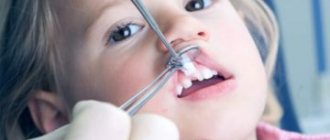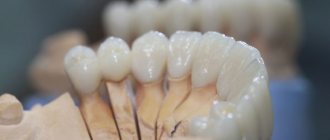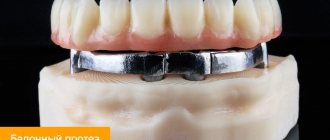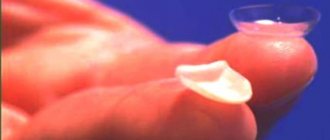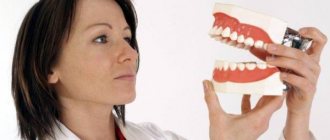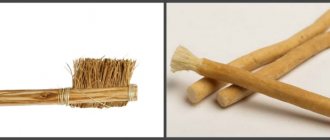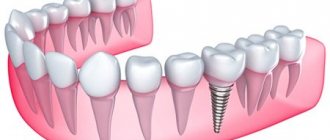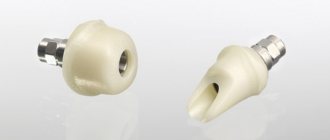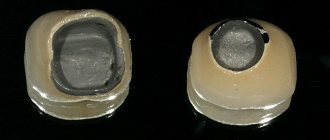Methods of prosthetics of the frontal zone
Orthopedic dentistry offers various ways to restore the shape, color, and functionality of dental units located in an aesthetically significant area. The choice of method depends on what problem needs to be solved.
Aesthetic prosthetics
If it is necessary to correct the shape and color of the front group of teeth, the best choice is microprosthetics. For the manufacture of microprostheses, modern materials are used (nanocomposite, ceramics, zirconium oxide), durable, biocompatible, capable of imitating the shade of natural enamel and its transparency. Veneers or lumineers are fixed to the outer surface of the enamel with dental adhesive. The thickness of the plates is no more than 0.2-0.3 mm, so to install them you do not need to heavily prepare the dental tissue - the doctor grinds off a thin layer of enamel for better adhesion of the plate to the dental tissue.
Restoring aesthetics with ceramic veneers and crowns based on zirconium dioxide
Restoration of the coronal part
If the supragingival part is severely destroyed (50% or more) and the root is healthy, reconstruction is performed using artificial crowns or restorative inlays. Before installation, the root canals are depulped, the root canals are filled, and the root is strengthened with a stump insert (according to indications). The crown is fixed to the prepared support with cement mortar.
Crowns or restorative inlays are made from an impression of the patient’s jaws. All-ceramic designs provide the best aesthetics. If you have problems with unconscious clenching or grinding of teeth during sleep, it is better to choose zirconium crowns. The most inexpensive are metal-ceramic products.
- Meliksetyan D.O. orthopedic dentist
Question:
Is zirconium the only option to qualitatively restore the front teeth?
Answer:
As an option, you can consider ceramics on gold. A budget solution is metal ceramics based on a cobalt-chromium alloy.
Question:
I have front teeth, but their color is terrible, red-brown (due to the water in the North) and cannot be corrected even with laser whitening. How to resolve the issue? Place metal-ceramic crowns on zirconium?
Answer:
You can take advantage of the possibilities of microprosthetics, for example, installing ceramic veneers.
< Previous Next >
If there are no teeth
Prosthetic options for missing front teeth:
- Bridge prosthesis
- suitable in case of replacement of 1-2, less often 3 incisors in a row. The non-removable design consists of several artificial crowns - 2 covering ones at the edges, 1-3 hanging ones in the center. A reliable method of prosthetics, but it requires depulpation and significant grinding of the supporting teeth. - Implantation
is the most physiological, reliable method of prosthetics. Suitable for replacing any number of missing or removed incisors. The implanted implant takes on all the functions of the natural root and prevents bone atrophy. Installation of an orthopedic system does not require turning healthy units. The prosthesis is fixed to the implants using a screw or cement method.
For periodontal diseases
With periodontitis and periodontal disease, there are not many ways to replace teeth. A splinting “clasp” is used, which will fix shaky units, but will not cure the disease. The only effective treatment method is implantation. Single-stage protocols with immediate loading are used, such as implantation on 4-6 implants or complex implantation.
The prosthesis for the front teeth must maintain an impeccable appearance for the entire period of service. To restore the frontal area, dentists recommend using orthopedic structures made of ceramics or zirconium. These materials have shades and degrees of transparency similar to natural enamel. The reconstructions look natural and do not stand out in the dentition. Popular metal-ceramics are reliable, but have a significant drawback - the appearance of a blue stripe at the base of the crowns, which reduces the aesthetic performance of the prosthesis.
Complete removable dentures - introduction to total dentures
The course will allow for competent planning and rehabilitation of patients with complete absence of teeth, including with the help of implants. Addresses the specifics of patient management - both anatomical issues (alveolar ridge atrophy, mucosal condition, position of individual teeth, skeletal class of occlusion, TMJ condition) and prosthetic issues (construction of occlusion, determination of jaw ratio, bite height, types of management, compensation curves, etc. ). The course will be useful for both doctors and dental technicians. Working with edentulous patients is considered non-standardly, from the point of view of each of the specialists. Prosthetics for patients with complete edentia is the most difficult task for a dentist. This is due to several problems. Patients are usually elderly and have psychological, social and general somatic problems. Also, great difficulties in the rehabilitation of such patients arise due to atrophy of the alveolar ridge of the jaws. The other side of the problem is that the cost of such work relative to fixed prosthetics is low. Therefore, doctors often refuse to treat such patients in their practice.
First day. Practice and theory. Work in the clinic.
I. Diagnostics and medical work. — Classification. Calculation of TRG (briefly, within the framework of a complete removable one). Photographing patients. Impressions from toothless jaws. Functional tests, edging, precise definition of boundaries. Fitting and marking the bite template. Analysis of errors. — Determination of bite height using the anthropometric method. Profilometry. — Phonetic tests for what and why. Determination of CS. — Registration of the position of the upper jaw using a facebow. — Collapsible base and checking the accuracy of determining the central point, Model analysis. Start. Anatomy. Stability of the position of teeth and dentures. The concept of balanced muscle pressure is the neutral zone. — Variability of condyle shapes in patients with complete edentia. II. Features of constructing occlusal relationships with complete edentia. What you need to know and pass on to your dental technician for correct teeth placement. — Determination of MAV, calculation method; — Functionally divided occlusal plane; — Selection of occlusal concept. Dynamic occlusion. Position of the lower incisors. — Determination of the skeletal class of the jaws. — Compensation curves. We are building. Spee and Wilson curve.
Second day. Practice. Working with the articulator.
III. What a dental technician needs to know if the doctor does not send the necessary data. — Model analysis. Model marking. Static occlusion. — Position of the occlusal plane. Calculation and transfer to the articulator. — Disocclusion of the dentition. Convergence and divergence of dentition during function. — Selection of front teeth. Shape and width of the frontal group of teeth. IV. Static occlusion. Artificial teeth. Staging. — Selection of a set of artificial teeth. Reading of headset cards. — The choice of headset depending on the skeletal class. - Position of teeth. Model guidelines. TIF - concept, Staub Cranial System, production in BPS - Ivoclar concepts, production in Candulor System-Prothetik. - position of teeth. Continued in order. TIF - concept, Staub Cranial System, setting in BPS - Ivoclar concepts, setting in "Candulor System-Prothetik". — Functional rationale for canine placement. Canine dominant. — Occlusal concept Prof. Gausch Innsbruck group. — Position of the first molars, the concept of the key of occlusion. — Mutual position of contacts in class I. - Position of teeth. Model analysis. TIF is a concept. - So is it necessary to place teeth along the axis of the alveolar ridge?! V. Dynamic occlusion - functional movements. — Occlusal concepts for constructing prosthetics. Descriptive. - speech distance. — Occluder or articulator. How to check lateral movements for each tooth. VI. How to test yourself, the dental technician and the patient. — Adjustments to removable dentures. Repair of finished prostheses. — Relocation.
Temporary prosthetics
The solution for the period while a permanent prosthesis is being made is removable products. More often, an immediate butterfly prosthesis is used for this purpose. This is an orthopedic system for replacing 1 or two front teeth. Structurally, these are 1-2 artificial crowns attached to a frame made of soft nylon. When installing, turning the support units is not required. Soft clippers (hooks) cover the supports at the base, holding the denture securely in the mouth.
An immediate denture is installed after the removal of an incisor or implantation of an implant. The task of the “butterfly” is to maintain the aesthetics of the frontal zone, prevent the displacement of dental units, and changes in the bite. If implantation or classic fixed prosthetics is not possible, temporary structures can be worn for a long time. As reviews confirm, with proper care and careful use, the “butterfly” lasts 2-3 years, then it needs to be replaced.
Prosthetics
All-On-4 is the most NON-TRAUMATIC technology of permanent dental prosthetics.
The All-On-4 method will be an excellent solution for you if you want to avoid additional bone grafting, sinus lifting and the expensive installation of bridges for 8-10 implants.
Dental prosthetics on 4 implants is safe, the secret is simple.
The fixed prosthesis is attached to 4 implants located at certain points;
Two implants are installed strictly vertically in the front of the jaw;
The other two are attached to the side of the jaw at an angle of 30-45 degrees.
Thanks to this arrangement of implants, stable fastening of the prosthesis is possible in the shortest possible time. The dentist fixes it immediately after implantation.
The installed denture feels like your OWN teeth, and also does not require additional effort and time to remove and clean.
All-on-6 implantation technology is an improved version of the All-on-4 concept. With this method, 6 implants are used: 2 are installed vertically in the frontal zone and 4 in the lateral sections at an angle of up to 60 degrees, with areas with a thin bone layer and maxillary the sinuses are not affected. The difference from All-on-4 is the increased number of supports, therefore, the functional load is distributed more evenly and thereby increases the reliability of the structure.
Features of “All on Six” implantation
All-on-6 dental implantation in Moscow. Different models of implants are used. If for prosthetics on 4 implants two-piece structures were used, then in this technique one-piece implants are used, which have a special type of thread. This allows them to be installed in deep sections of bone tissue, which are harder and have not undergone atrophy.
Important!!! When using the All-on-6 and All-on-4 techniques, there is no need for bone grafting or sinus lifting, which means you minimize your costs. A beautiful smile in a day. Long-term temporary crowns are quite aesthetic and functional. You will leave the clinic with teeth already in place.
Stages of implantation according to the All on 6 protocol
All-on-6 dental implantation in Moscow. The first step is diagnosis. Computed tomography (CT) is mandatory, on the basis of which virtual planning of the implantation process is carried out. Based on the condition of the jaw bone, its density and height, the dentist, using a special computer program, models the “implants-prosthesis” system.
Advantages of implantation “All on six implants”
This unique technology allows implantation even for those patients who have been missing teeth for a long time, that is, there is pronounced atrophy of bone tissue. In addition, the technique is also used for serious diseases of periodontal tissue: diseased teeth are removed, the sockets are cleaned, and implants are implanted into deep parts of the bone that are not subject to inflammation. There are also other important advantages:
Easy installation of implants and minimal trauma, no bone grafting (no massive gum incisions or osteoplasty);
Teeth per day from the moment of examination to obtaining a full smile takes no more than 3 days. After implantation, crowns are installed and you immediately have teeth.
The cost is only 6 implants per jaw, which significantly reduces costs (for comparison, traditional implantation uses 8-12 titanium roots);
The service life is about 10 years, subject to the dentist’s recommendations.
Cost of All-on-6 implantation
The final figure, as a rule, depends on the brand of implants used; we are currently running a promotion. Prosthetics “Everything on 6 implants” turnkey: The price includes: consultation and initial examination, treatment plan, six implants + temporary prosthesis with installation + permanent prosthesis made of metal-ceramic crowns RUB 258,000 . instead of 350,000 rubles, from zirconium crowns 368,000 rubles. instead of 490,000 rub..
The most advanced method of complete dental implantation to date
Who are the All on 4 and All on 6 methods recommended for?
All-on-6 dental implantation in Moscow. Of course, if we are talking about a single implant, then this option is not for you. But patients with significant or complete loss of teeth, patients with significant bone atrophy, with old bridge structures (subject to an unsatisfactory prognosis of the supporting teeth), with periodontal diseases, with removable dentures, etc., receive excellent and most importantly quickly complete dental rehabilitation.
Technology proven over the years, the best implantologists and maxillofacial surgeons will select a financially affordable option for aesthetic permanent prosthetics; this procedure allows you to smile on the day of surgery. Give yourself or your loved ones a new quality of life!
NoraDent dental specialists first of all perform a qualitative assessment of all factors to select the correct treatment protocol and obtain a reliable result. We will be happy to help restore the health, beauty and attractiveness of your smile.
Features of prosthetics on implants
Implantation of anterior incisors is performed using a one-stage or two-stage method.
If the clinical situation allows, preference is given to simultaneous implantation with immediate loading. Temporary dentures for the front teeth are made of lightweight metal-plastic. They are fixed on titanium supports within 72 hours after the intervention. Installation of a permanent orthopedic structure is carried out after complete fusion of the implants with the jaw bone.
The two-stage protocol provides for the installation of a permanent fixed prosthesis after the engraftment of the titanium roots is completed (on the lower jaw after 2-3 months, on the upper jaw after 4-6 months). Before installing a permanent structure, the defect is compensated with a temporary prosthesis (immediate prosthesis, adhesive bridge).
Reviews
5/5 There was a need to insert teeth.
Friends advised Tserekon on Andropov. Signed up for a free appointment at a time convenient for you. The doctor examined me and suggested installing a metal-ceramic prosthesis in place of the missing tooth, as well as inlays for two more damaged ones, which would save them. Impressions were made on the same day, and after 7 days the finished structures were fixed to me. Grateful to the doctors. I'm delighted with the result. I will recommend you to colleagues and friends. Vasily, 40 years old
5/5 A front tooth was chipped, which completely crumbled after building up.
I decided to get a crown in Cerekon, but the dentist upset me with the need to extract the root (it was inflamed). After removal, I underwent a course of antibacterial treatment. After 15 years I came for a follow-up appointment, where I was given an implant with a guarantee!!! And a zirconium crown. Yes, it’s expensive, but I’m still young and I still need teeth. If anything happens, come to you immediately. Thanks a lot! Alexander, 28 years old
5/5 A mouth full of crowns, living and non-living teeth. The budgetary institution reported that it makes no sense to change them and treat them; you need to tear them out and install either false jaws or implants with prostheses. I decided to contact Cerekon on the recommendation of friends. Oh miracle! It's not all bad. The necessary crowns were replaced, the rest were cured. Thank you for saving my teeth. You now have complete confidence. Valentina, 50 years old Useful information
Sign up for a free consultation:
Sign up now +7(495) 105 92 30 See all prices for dentures
Features of the restoration of the upper and lower incisors
Prosthetics of the upper anterior teeth is not fundamentally different from the restoration of the frontal area of the lower jaw. The stages and treatment methods are similar. The only difference is that the upper incisors require more attention to aesthetics, since they are the ones that are visible when smiling (with the exception of an open “American” smile).
Prosthetics of the lower front teeth does not place increased demands on beauty, since the lower incisors are less involved in the formation of a smile. Functionality is a priority - it is important to quickly install dentures on the lower jaw, which will fully participate in chewing.
Expert of the article Meliksetyan Daniel Oganesovich orthopedic dentist
Work experience15 years
Dental restoration methods
Microprosthetics is a novelty in modern medicine. Microprosthetics allows you to work with a small amount of material, avoiding the installation of bulky structures in the oral cavity. There are two types of microprostheses: inlays (installed inside the tooth) and veneers (external linings).
Dental prosthetics with inlays
One of the types of microprosthetics (the process of eliminating defects in the oral cavity without using a large amount of filling material) is prosthetics with inlays. Ceramic inlays are a kind of micro-inserts into the tooth cavity, characterized by very high strength and aesthetics, identical to healthy tooth enamel.
Microprosthetics with veneers
We can solve the aesthetic and functional problems of your upper and lower front teeth with the help of veneers - ceramic plates securely fixed to their outer surface. Unlike crowns, when installing veneers, the teeth are practically not ground down, and the absence of metal in the design provides an unsurpassed cosmetic effect.
High-quality materials and unique veneer manufacturing technologies used in the clinic allow us to achieve excellent results!
Single dental crowns
A crown is one of the methods of dental restoration of a tooth, in which a prosthesis made in a laboratory is fixed to the tooth. Dental crowns completely cover the visible part of the tooth and are fixed with cement. To make a dental crown that exactly follows the shape of your teeth, the doctor takes an impression of both jaws, from which a plaster model is made.
Along with traditional metal-ceramic crowns on frames made of chromium-cobalt alloy, the clinic offers prosthetics with crowns on frames made from new materials that are fundamentally different from all existing materials in dentistry - zirconium oxide.
You may also be interested in:
Patient reviews. Works of doctors Video about the clinic
Sign up for a consultation
three ROOTT specialists + diagnostics as a gift
All specialists Our specialists
Restoration of anterior teeth is a very responsible procedure, the result of which should be dentures of ideal shape, color, with “natural” light reflectivity, etc. Explore examples of work in the photo in the gallery of the ROOTT website.
Victoria Vladimirovna Prus
dentist-therapist
Shiyka Oksana Grigorievna
dentist-therapist
